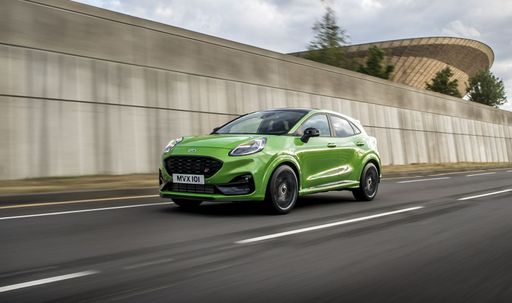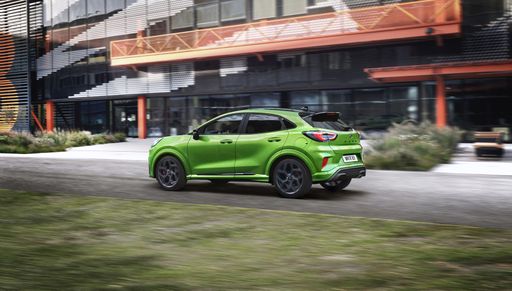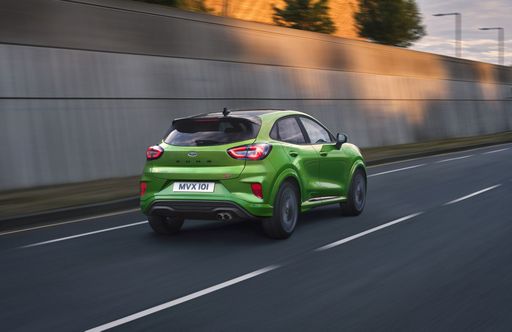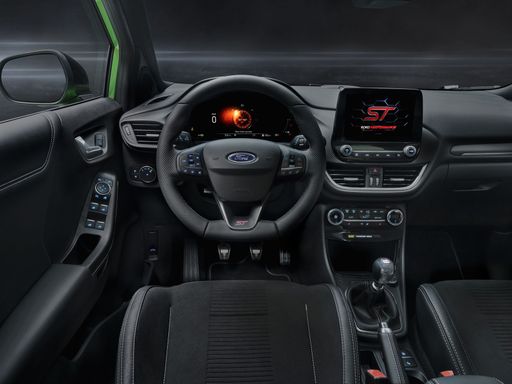Ford Puma VS Elaris Dyo – Specs, Efficiency & Price Comparison
Which model is the better choice – the Ford Puma or the Elaris Dyo? We compare performance (168 HP vs ), boot capacity (523 L vs ), efficiency (13.10 kWh5.40 L vs ), and of course, the price (24800 £ vs ).
Find out now which car fits your needs better!
The Ford Puma (SUV) is powered by a Petrol MHEV or Electric engine and comes with a Manuel or Automatic transmission. In comparison, the Elaris Dyo () features a engine and a gearbox.
When it comes to boot capacity, the Ford Puma offers 523 L, while the Elaris Dyo provides – depending on what matters most to you. If you’re looking for more power, you’ll need to decide whether the 168 HP of the Ford Puma or the of the Elaris Dyo suits your needs better.
There are also differences in efficiency: 13.10 kWh5.40 L vs . In terms of price, the Ford Puma starts at 24800 £, while the Elaris Dyo is available from .
Compare all the key specs now and find out which model fits your lifestyle best!
Ford Puma
The Ford Puma presents itself as a stylish compact SUV with a distinctive design that combines practicality with a dynamic driving experience. Its sleek lines and sporty aesthetics make it stand out on the road, while the interior offers a comfortable and tech-savvy environment. With an emphasis on efficiency and a smooth drive, the Ford Puma is well-suited for both urban commutes and countryside adventures.
details @ puma.fordpresskits.com
@ puma.fordpresskits.com
 @ puma.fordpresskits.com
@ puma.fordpresskits.com
 @ puma.fordpresskits.com
@ puma.fordpresskits.com
 @ puma.fordpresskits.com
@ puma.fordpresskits.com
Elaris Dyo
The Elaris Dyo stands out in the compact electric vehicle market with its sleek design and modern aesthetic. Its interior is designed with a focus on comfort and convenience, featuring intuitive technology that enhances the driving experience. On the road, the Dyo delivers a smooth and agile performance, making it an ideal choice for urban environments.
details

|
|
|
|
|
Costs and Consumption |
|
|---|---|
|
Price
24800 - 36300 £
|
Price
-
|
|
Consumption L/100km
5.4 - 6 L
|
Consumption L/100km
-
|
|
Consumption kWh/100km
13.1 - 13.7 kWh
|
Consumption kWh/100km
-
|
|
Electric Range
364 - 376 km
|
Electric Range
-
|
|
Battery Capacity
43 kWh
|
Battery Capacity
-
|
|
co2
0 - 136 g/km
|
co2
-
|
|
Fuel tank capacity
42 L
|
Fuel tank capacity
-
|
Dimensions and Body |
|
|---|---|
|
Body Type
SUV
|
Body Type
-
|
|
Seats
5
|
Seats
-
|
|
Doors
5
|
Doors
-
|
|
Curb weight
1316 - 1563 kg
|
Curb weight
-
|
|
Trunk capacity
456 - 523 L
|
Trunk capacity
-
|
|
Length
4186 - 4226 mm
|
Length
-
|
|
Width
1805 mm
|
Width
-
|
|
Height
1550 - 1555 mm
|
Height
-
|
|
Payload
367 - 469 kg
|
Payload
-
|
Engine and Performance |
|
|---|---|
|
Engine Type
Petrol MHEV, Electric
|
Engine Type
-
|
|
Transmission
Manuel, Automatic
|
Transmission
-
|
|
Transmission Detail
Schaltgetriebe, Automat. Schaltgetriebe (Doppelkupplung)
|
Transmission Detail
-
|
|
Drive Type
Front-Wheel Drive
|
Drive Type
-
|
|
Power HP
125 - 168 HP
|
Power HP
-
|
|
Acceleration 0-100km/h
7.4 - 9.8 s
|
Acceleration 0-100km/h
-
|
|
Max Speed
160 - 210 km/h
|
Max Speed
-
|
|
Torque
170 - 290 Nm
|
Torque
-
|
|
Number of Cylinders
3
|
Number of Cylinders
-
|
|
Power kW
92 - 124 kW
|
Power kW
-
|
|
Engine capacity
999 cm3
|
Engine capacity
-
|
General |
|
|---|---|
|
Model Year
2024 - 2025
|
Model Year
-
|
|
CO2 Efficiency Class
D, E, A
|
CO2 Efficiency Class
-
|
|
Brand
Ford
|
Brand
-
|
Ford Puma
A Glimpse into the Ford Puma: Fusing Style with Innovation
The Ford Puma stands as a testament to modern engineering fused with style. This compact SUV is not just about aesthetics but brings to the table an array of technical innovations, topped with the reliability and performance Ford is known for. Let's delve into the technical specifics and innovative features that make the Ford Puma a stellar choice for any car enthusiast.
Powertrains and Performance
The Ford Puma is offered with a range of powertrains designed to deliver optimal performance whilst minimising fuel consumption. At the heart of this compact SUV is the 1.0 EcoBoost Hybrid engine, available in both 125 PS and 155 PS variants. This engine is a marvel of engineering, optimised to deliver power efficiently with a remarkable fuel consumption ranging from 5.4 to 5.7 L/100km for manual versions, and slightly higher for the automated variants.
The top-end 1.5 EcoBoost ST variant takes performance up a notch, providing a robust 200 PS that propels the Puma from 0 to 100 km/h in just 6.7 seconds. This variant is perfect for those who prioritise performance and exhilaration in their driving experience.
Mild-Hybrid Technology
The Puma's mild-hybrid technology plays a significant role in enhancing fuel efficiency and reducing emissions. By utilising a belt-driven integrated starter/generator, the Puma recovers energy usually lost during braking, storing it in a 48-volt lithium-ion battery. This stored energy is then used to assist the engine, providing a boost during acceleration and smoothing out the stop-start technology, ultimately leading to enhanced fuel efficiency.
Design and Comfort
The Ford Puma does not compromise on style and comfort with its ergonomic and stylish design. The SUV is available in multiple trims including the ST-Line, Titanium, and the luxurious Vignale editions, each offering unique aesthetic and technological enhancements. These trim levels provide varied offerings in terms of both exterior styling and interior comfort, ensuring there's a Puma that meets every personal preference.
Inside, the Puma offers a driver-focused cockpit with advanced technological integrations such as the SYNC 3 infotainment system, providing seamless connectivity and intuitive control of the vehicle's numerous technological features.
Safety and Technology
Safety remains paramount, and the Ford Puma is equipped with the latest security and technology features. It boasts the Ford Co-Pilot360 suite which includes adaptive cruise control, pre-collision assist with autonomous emergency braking, and lane-keeping assist, enabling a safer driving experience on both city roads and highways.
Versatility and Practicality
Beyond performance and safety, the Ford Puma shines in its versatility. With a boot capacity of 456 litres, it offers ample space for all sorts of adventures, whether you're heading on a family trip or loading sports equipment. Its innovative MegaBox is an extra storage solution, providing additional space below the boot floor.
The Puma's agile handling, paired with its compact dimensions—spanning a length of 4186 to 4266 mm and a width of 1805 mm—makes it an ideal choice for urban commuting and beyond.
Conclusion
In conclusion, the Ford Puma beautifully blends practical features with cutting-edge technology, offering a package that appeals to both the tech-savvy driver and those seeking comfort and reliability. Its range of innovative features, powerful yet efficient engine options, and a design that is both functional and stylish make it a frontrunner in the compact SUV market.
Whether you're drawn by the efficient mild-hybrid engines or the robust performance of the ST variant, the Ford Puma represents a modern driving experience where innovation meets everyday usability.
Elaris Dyo
Unveiling the Elaris Dyo: A New Chapter in Electric Motoring
The automotive industry is consistently pushing the boundaries of innovation and sustainable technology. Stepping into this evolving landscape, the Elaris Dyo emerges as a frontrunner in electric mobility. Combining efficiency with style, this compact hatchback is designed to cater to the urban dwellers seeking an eco-friendly drive without compromising on modern comfort.
Performance and Efficiency: A Powertrain Designed for the Future
At the heart of the Elaris Dyo lies an impressive electric motor producing 48 PS, translating to 35 kW of power. This motor operates in tandem with an automatic transmission and a front-wheel drive system, ensuring a smooth and responsive driving experience. The car boasts a top speed of 110 km/h, offering a practical solution for city commutes.
Efficiency is at the forefront of this vehicle's engineering. With a consumption rate of 14.9 kWh per 100 km, the Dyo provides an electric range of up to 265 km on a single charge. This makes it an ideal choice for daily drives and urban adventures, aligning perfectly with the growing demand for eco-conscious transportation.
Innovative Design and Compact Dimensions
The Elaris Dyo is not only about performance but also about smart design. Classified as a hatchback with a sleek silhouette, its compact dimensions (measuring 2871 mm in length, 1563 mm in width, and 1568 mm in height) make it an agile contender in urban environments. Despite its compact size, the Dyo offers a boot capacity of 229 litres, catering to everyday luggage needs.
Eco-Friendly Features and Sustainability
The Elaris Dyo takes sustainability seriously. Its CO2 efficiency is marked with a class A rating, producing zero emissions (0 g/km), which is critical for reducing environmental impact. The regenerative braking system ensures that energy is conserved and optimised, while the lightweight frame, with a kerb weight of only 965 kg, enhances efficiency.
Comfort Meets Convenience: Inside the Elaris Dyo
With seating for two, the Dyo is crafted for minimalism and practicality. The intuitive layout includes advanced infotainment systems and connectivity options, ensuring that every journey is as comfortable as it is engaging. The three-door configuration allows easy access into the cabin, making it perfect for those who favour nimble urban navigation.
Conclusion: Is the Elaris Dyo the Future of Urban Mobility?
Priced at €24,900, the Elaris Dyo offers an attractive package for those prioritising efficiency, sustainability, and innovation. It encapsulates what the next generation of city cars should be: compact, energy-efficient, and environmentally friendly. As we navigate towards a greener future, the Elaris Dyo stands as a testament to where mobility is headed, providing an excellent choice for eco-conscious drivers seeking practical urban transport solutions.
The prices and data displayed are estimates based on German list prices and may vary by country. This information is not legally binding.
